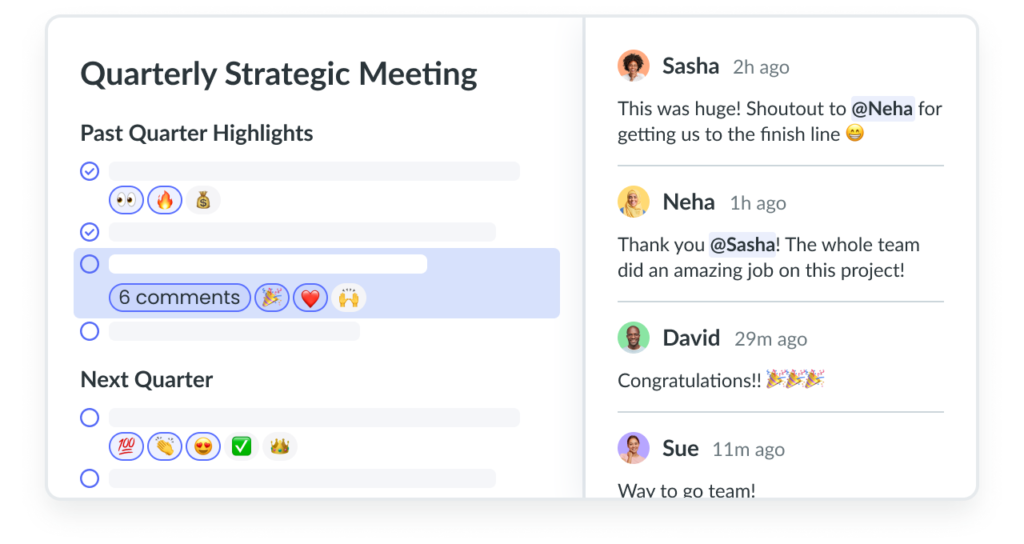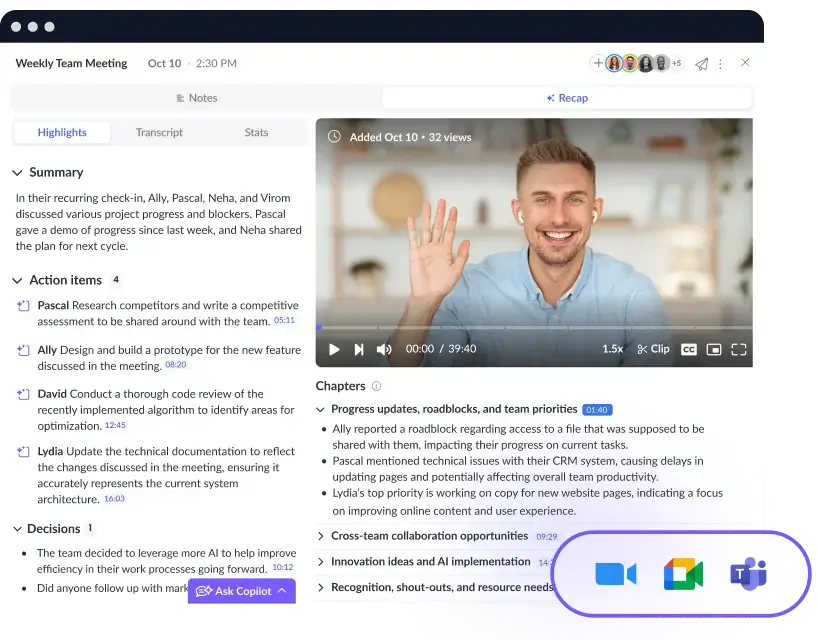Micro-Feedback: Why It’s Important and How It Can Encourage High-Performing Employees
Learn what micro-feedback is and 8 ways to implement it in your workplace to inspire high performance.
We all know that giving regular and personalized feedback is a key element of a successful manager-employee relationship. When provided as a basis for improvement, feedback allows employees the opportunity to work through task pain points, communicate with their manager often, and can also allow them to further thrive in the workplace.
Unfortunately, some managers wait until annual performance reviews to give any meaningful feedback at all. We get it, you may be too busy to give every employee detailed feedback as often as you’d like, but waiting too long between feedback conversations can create confusion and even resentment amongst your employees.
Let’s talk about micro-feedback: a proven strategy that can transform mediocre teams into great ones using a handful of simple techniques.
What is micro-feedback?
Micro-feedback combines two effective workplace management techniques: micro-messaging with nudges and, you guessed it, feedback.
Micro-messaging with nudges means using internal messaging platforms to boost workplace engagement. If you’ve ever used Slack or Microsoft Teams to nudge a colleague about the great work they did following an important project or presentation, you’ve already begun your micro-feedback journey.
Feedback means encouraging change in your employees’ behaviour to get them closer to your desired outcome. By providing your employees with positive reinforcement and frequent intentional feedback, you can implement a micro-feedback system to help them achieve higher performance.

Feedback culture
Create a feedback culture by giving shoutouts to your teams and encouraging feedback with a tool like Fellow.

Benefits of micro-feedback
How exactly can micro-feedback improve efficiency in teams? We know how stressful it can be to meet with your boss for a performance review when you haven’t received any true feedback in months. Micro-feedback implements regular feedback loops to create a healthier workplace environment by building trust and empowering your employees. After all, happy workers are often the most productive ones.
The best managers are also willing to help their team in areas of self-improvement. By regularly checking in, being tuned into your employees’ day-to-day work life, and giving ongoing advice, you will create a culture of continuous improvement and ease tension in the workplace.
Additionally, providing micro-feedback normalizes feedback culture and will allow employees to act immediately, rather than after a task is complete.
8 ways to use micro-feedback in the workplace
- Foster greater workplace friendships
- Keep the feedback concise
- Change up the medium
- Provide feedback often
- Schedule micro-feedback sessions
- Give positive feedback too
- Reinforce good habits
- Use a scoring scale
1 Foster greater workplace friendships
We all love how it feels to receive a nice note from a colleague every now and then. Next time you recognize a teammate excelling in their role, pass along some good feedback. It can be as simple as complementing their excellent presentation skills or acknowledging the insightful comment they made in a meeting with a Slack message. This will foster friendship with your teammates and help create an environment where open communication and frequent feedback is normalized. You can also provide your own supervisor with positive feedback. Even managers want to know when they’re doing a great job!
2 Keep the feedback concise
Eliminate the need for long and impersonal performance reviews. You should be communicating with your team often enough that you aren’t in need of monthly hour-long feedback conversations.
Ensure you are giving concise verbal and written feedback often. Verbal micro-feedback should be about 60 to 90 seconds – long enough to get your point across, but not so long that it’s distracting or disrupts the individual’s workflow. When delivering written micro-feedback, use short lists or clear bullet points. Let the employee know you are happy to chat further, answer any questions about the feedback, or help them develop a plan to implement the feedback you gave. Give them the opportunity to provide you with feedback often as well.
3 Change up the medium
Challenge yourself to be creative with your feedback delivery methods. If you have an employee that you rarely see face-to-face because you’re both working remotely, throw in some feedback via video call when you’re able. If you have an employee with whom you chat in-person on a daily basis, try sending them a message, a voice memo, a survey, or a congratulatory gif instead!
Make micro-feedback a regular team-building activity (note that this delivery method should be used for positive feedback only). Give shout-outs to those who recently did awesome things at work, and give others the opportunity to elaborate or speak up too. Then, challenge your team to think of ways to make these awesome things they did even more awesome.
4 Provide feedback often
Take action today. Did you know that Great Britain’s cycling team went from underdog to six-time Tour de France champion in under a decade using micro-feedback techniques? The traditional feedback loop has four parts: taking action, receiving feedback, reflecting on that feedback, and making a plan. Former cycling team head Sir David Brailsford shortened the loop by giving feedback after each action to create nearly instant changes.
Want to adopt the Great Britain model of success? Use small corrections, reactions, and check-ins that are individualized. By providing feedback often, you’ll discover that small wins equal fast changes.
5 Schedule micro-feedback sessions
You may be thinking, “I don’t have time for more meetings in my calendar!” Luckily, micro-feedback sessions are meant to give you some time back. Rather than scheduling quarterly or monthly hour-long conversations with your entire team, schedule one-on-one meetings often.
One-on-ones should not be status updates. These meetings should be an opportunity to build trust, coach employees on their priorities, and, of course, exchange feedback.
6 Give positive feedback too
Even constructive feedback can be positive! Feedback should be honest, but that doesn’t mean it needs to be harsh. According to the Harvard Business Review, positive feedback is critical for learning, but only if it is specific. When giving positive feedback, use examples and let the person know that this is a time to focus on their strengths.
For any feedback to be helpful, there must also be existing trust between the feedback provider and the feedback recipient. Ask your direct reports how they like to receive both good and bad feedback, and ensure they’re comfortable with your delivery method.
Lastly, remember to ask questions that stimulate reflection and encourage further exploration of your teammate’s strengths. Positive feedback is essential to help managers enhance the best qualities within their teams.
7 Reinforce good habits
According to McKinsey & Company, one of the best ways to reinforce good habits in the workplace is by breaking the habit down into three parts: a cue, a routine, and a reward. A cue is the circumstance that causes an action to take place, the routine is the action, and the reward is the reaction. A workplace example could look something like this:
A new employee wants to gain the trust of his colleagues. He wants them to know that he is hardworking and capable of delivering high-level results (the cue). Due to this desire to succeed, this employee is collaborative and detail-oriented, and goes the extra mile to do a great job on work projects and tasks (the routine). This employee is then rewarded by being offered a leadership role on a future project and praised for being an excellent member of the team (the reward). The cycle continues.
Whether we admit it or not, everyone loves to feel appreciated from time to time. Reinforce good habits and watch your employees’ work reflect it.
8 Use a scoring scale
After each scheduled micro-feedback session, ask the individual to rate the meeting on a scale of 1 to 10. You can use a scaling system like this to assess the session’s success, further individualize your meetings, and stay up-to-date with your employees’ needs. Some individuals may have a difficult time providing verbal feedback in meetings when they feel like they’re put on the spot. By asking them to rate the meeting, you will get them to think more deeply about what went well and what didn’t.
You can also use a scoring scale in other areas at work. After the completion of a major project, try asking your team to rate the overall product. Then, have them practice giving themselves feedback, along with members of their team. Remember that employees must have established trust with each other to feel safe doing so. Start with positive feedback and watch your team go from feedback hesitant to feedback champions!
Small changes for big wins
Providing micro-feedback may seem like extra work, but it’s likely something you’re already doing. When you stop by your colleague’s desk to tell them that their graphic design skills are sublime, or chat with a supervisor about how they can better communicate with you, you’re already using micro-feedback techniques.
Now, take that micro-feedback and be more intentional with it. See an action, react, and create a plan immediately. After all, with a bit of grit and a lot of consistency, we can achieve Great Britain-level success in our daily lives, too.











